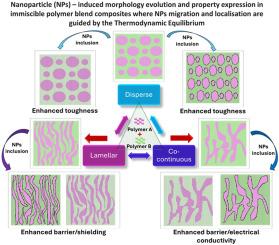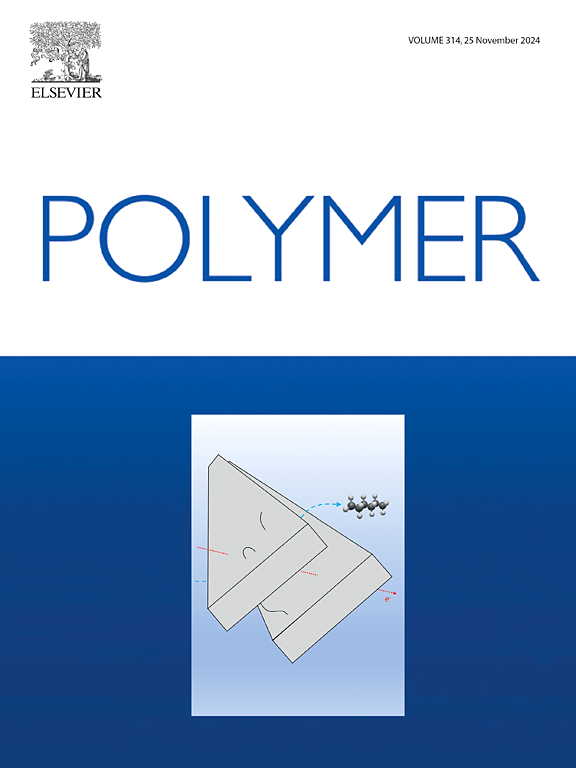Nanoparticle-induced morphology evolution and property expression in immiscible polymer blend composites−A review of fundamental understanding on nanoparticle migration and interface crossing
IF 4.1
2区 化学
Q2 POLYMER SCIENCE
引用次数: 0
Abstract
This article provides a critical overview of the fundamentals related to the migration and localization of nanoparticles in immiscible polymer blends, with a discussion on recent advances, including knowledge gaps related to the effect of nanofiller localization on the properties of polymer blend composites. Thermodynamic equilibrium primarily guides the migration and localization of nanoparticles in immiscible polymer blends. However, the effect of kinetics cannot be ignored when nanoparticles are initially distributed in a thermodynamically less favored phase. By controlling various process parameters during melt processing, one can exploit the effect of kinetics for tailoring the localization of nanoparticles. Furthermore, filler particles can be localized at the interface by surface modification of the filler particles and inducing interfacial reactions or by tailoring their wettability using surface functionalization. Such control of the migration of nanoparticles is crucial for getting desired properties, such as high electrical conductivity and low percolation threshold of conductive polymer blend nanocomposites. By providing a holistic understanding of all critical aspects (thermodynamic and kinetic) related to the control of migration of all commonly used nanoparticles and its subsequent effect on properties, this review offers a direction for future advances in the development of high-performance multiphase nanocomposite materials used for various high-end applications.

纳米粒子诱导的不相溶聚合物共混复合材料形貌演变和性能表达--综述对纳米粒子迁移和界面穿越的基本认识
本文对纳米粒子在不相溶聚合物共混物中的迁移和定位的基本原理进行了重要概述,并讨论了最新进展,包括纳米填料定位对聚合物共混复合材料性能影响方面的知识空白。热力学平衡主要指导纳米粒子在不相溶聚合物共混物中的迁移和定位。然而,当纳米粒子最初分布在热力学较不利的相中时,动力学的影响也不容忽视。通过控制熔融加工过程中的各种工艺参数,可以利用动力学效应来定制纳米粒子的定位。此外,还可以通过对填料颗粒进行表面改性和诱导界面反应,或利用表面官能化定制其润湿性,从而将填料颗粒定位在界面上。这种对纳米粒子迁移的控制对于获得理想的性能至关重要,例如导电聚合物共混纳米复合材料的高导电性和低渗流阈值。本综述全面介绍了与控制所有常用纳米粒子的迁移及其对性能的影响有关的所有关键方面(热力学和动力学),为今后开发用于各种高端应用的高性能多相纳米复合材料指明了方向。
本文章由计算机程序翻译,如有差异,请以英文原文为准。
求助全文
约1分钟内获得全文
求助全文
来源期刊

Polymer
化学-高分子科学
CiteScore
7.90
自引率
8.70%
发文量
959
审稿时长
32 days
期刊介绍:
Polymer is an interdisciplinary journal dedicated to publishing innovative and significant advances in Polymer Physics, Chemistry and Technology. We welcome submissions on polymer hybrids, nanocomposites, characterisation and self-assembly. Polymer also publishes work on the technological application of polymers in energy and optoelectronics.
The main scope is covered but not limited to the following core areas:
Polymer Materials
Nanocomposites and hybrid nanomaterials
Polymer blends, films, fibres, networks and porous materials
Physical Characterization
Characterisation, modelling and simulation* of molecular and materials properties in bulk, solution, and thin films
Polymer Engineering
Advanced multiscale processing methods
Polymer Synthesis, Modification and Self-assembly
Including designer polymer architectures, mechanisms and kinetics, and supramolecular polymerization
Technological Applications
Polymers for energy generation and storage
Polymer membranes for separation technology
Polymers for opto- and microelectronics.
 求助内容:
求助内容: 应助结果提醒方式:
应助结果提醒方式:


